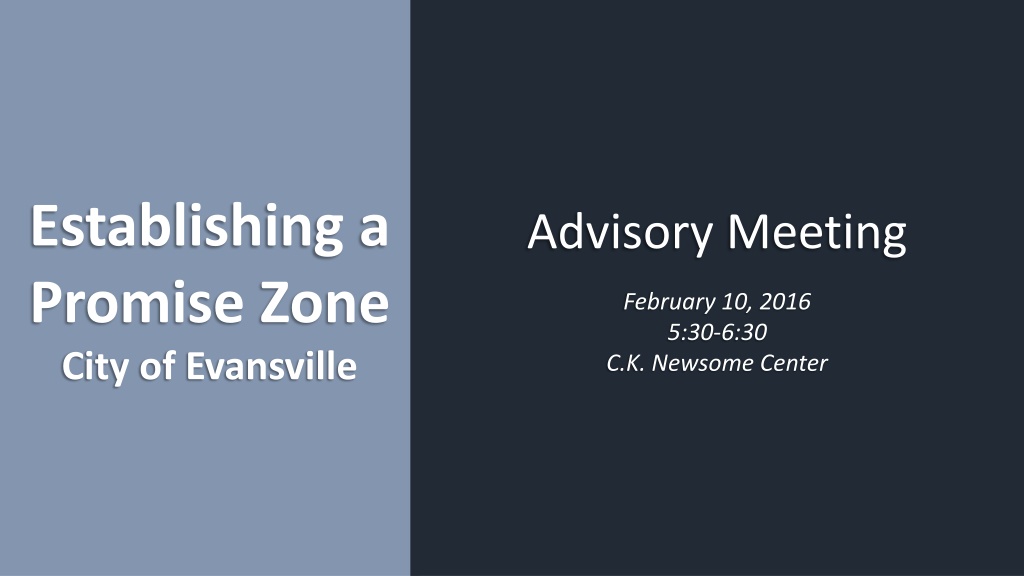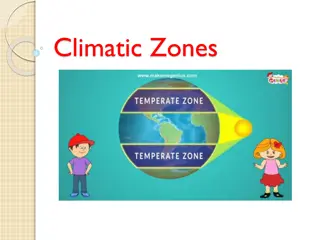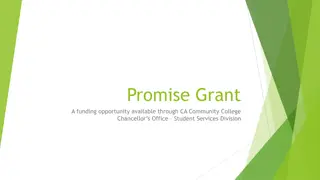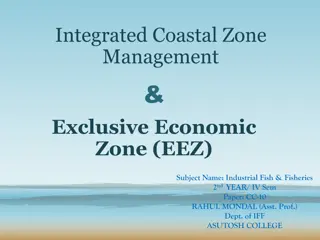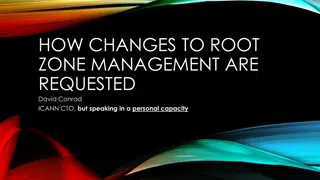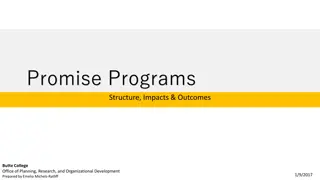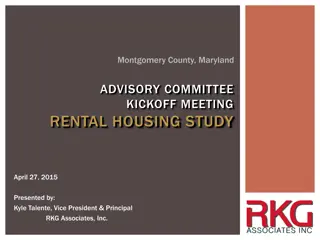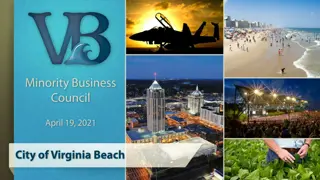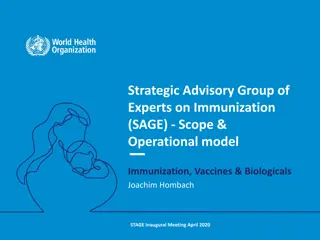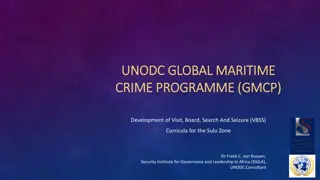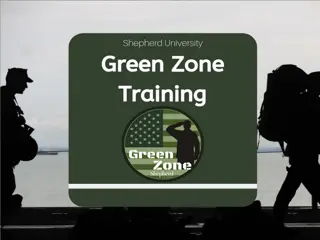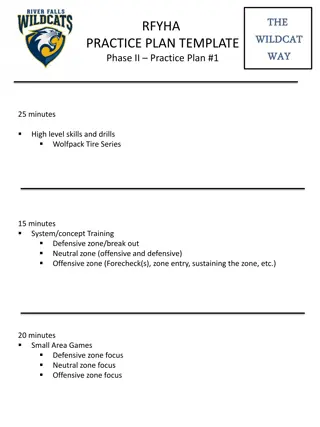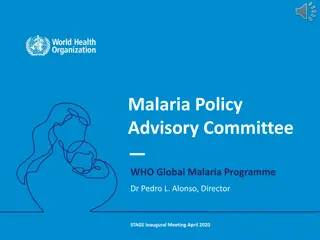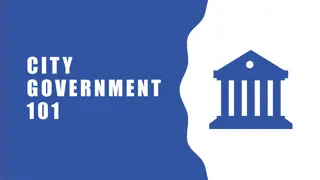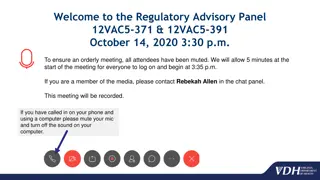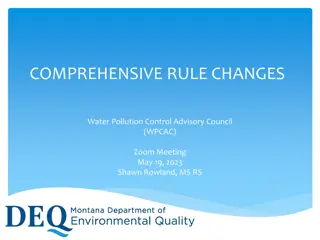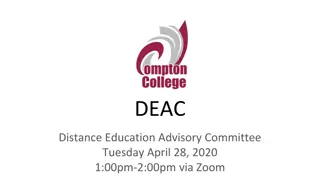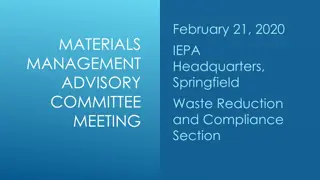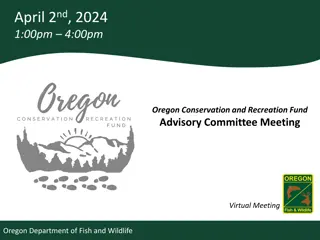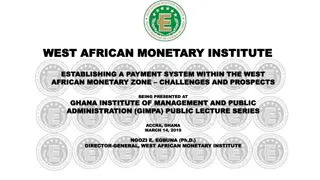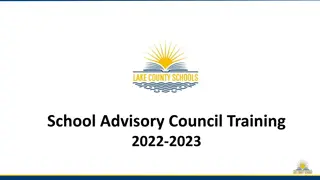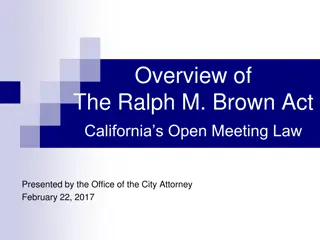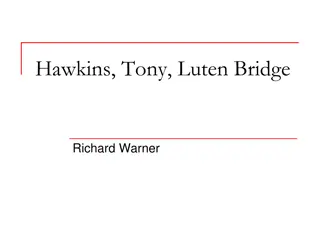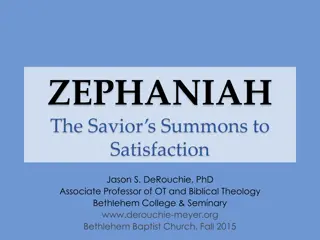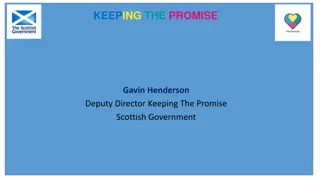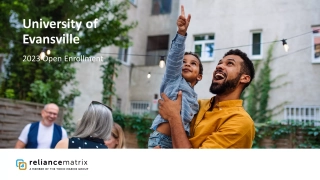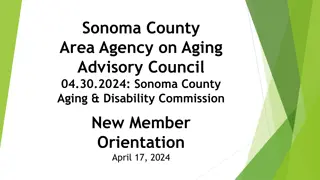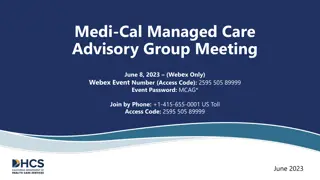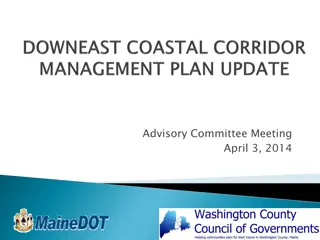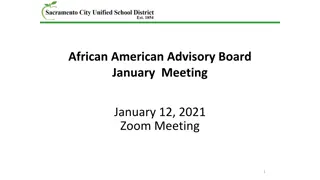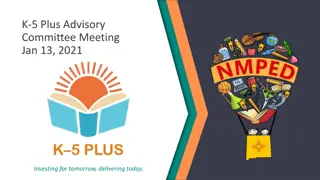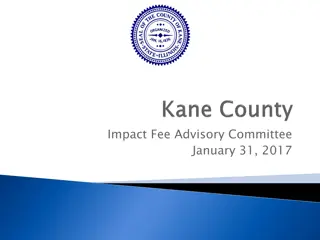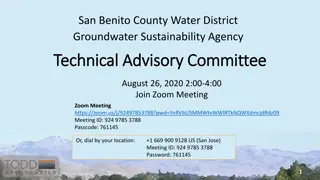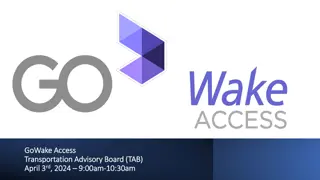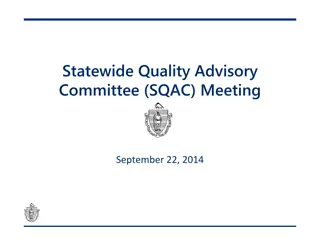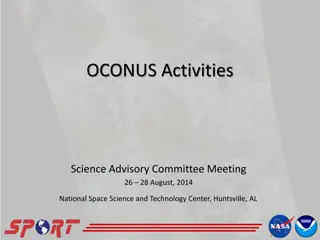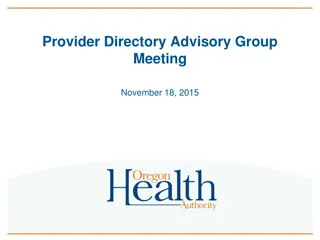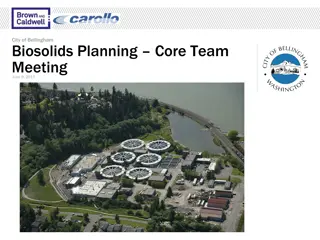Establishing a Promise Zone City of Evansville Advisory Meeting
This advisory meeting on February 10, 2016, aims to discuss the Promise Zone Initiative in high-poverty communities, highlighting the planning process, goals, strategies, and eligibility criteria. The event focuses on the benefits of becoming a Promise Zone and the federal assistance and programs available to revitalize communities.
Download Presentation

Please find below an Image/Link to download the presentation.
The content on the website is provided AS IS for your information and personal use only. It may not be sold, licensed, or shared on other websites without obtaining consent from the author. Download presentation by click this link. If you encounter any issues during the download, it is possible that the publisher has removed the file from their server.
E N D
Presentation Transcript
Establishing a Promise Zone City of Evansville Advisory Meeting February 10, 2016 5:30-6:30 C.K. Newsome Center
Advisory Group: Why You Are Here Passion, knowledge, and expertise in Promise Zone goal areas Genuine concern for our community Strength in multi-sector partnership and collaboration
Agenda A. Overview of the Promise Zone Initiative B. Planning Process C. Goals and Selected Activity/Strategies D. Additional Feedback
A. Overview of the Promise A. Overview of the Promise Zone Initiative Zone Initiative
Background and Purpose Promise Zones are high-poverty communities where the federal government will partner with and invest in high-poverty urban, rural, and tribal communities to create jobs, increase economic activity, improve educational opportunities, leverage private investment, and reduce violent crime. Communities must compete in a transparent application process and demonstrate the strength and effectiveness of their local partners' commitment in order to become Promise Zones. Each designated Promise Zone will be asked to identify a set of outcomes they will pursue to revitalize their communities, develop a strategy supporting those outcomes, and realign resources accordingly.
Eligibility (continued) All of the following must be present: Zone must encompass one or more census tract(s) or portions of census tract(s) across a contiguous geography (One adjoining boundary-cannot include separate areas). The rate of overall poverty or Extremely Low Income rate (whichever is greater) must be at or above 33 percent. Population of at least 10,000 residents. Local leadership must demonstrate commitment to the Promise Zone effort. Proposed Promise Zones must identify one Lead Applicant.
Benefits of Becoming a Promise Zone Promise Zones will be assigned Federal staff to help navigate the array of Federal assistance and programs already available to them. Department of Agriculture Department of Commerce Corporation for National and Community Service Department of Education Subject to enactment by Congress, businesses investing in Promise Zones or hiring residents of Promise Zones will be eligible to receive tax incentives. Department of Health and Human Services Department of Housing and Urban Development Department of Justice Promise Zones will receive any available (a) preference for certain competitive Federal programs and (b) technical assistance. Department of Labor Small Business Administration U.S. Department of the Treasury
B. Planning Process B. Planning Process
Planning Process Application Due: February 23 Lead Applicant: ECHO Housing Corporation (with funding by the City of Evansville) Collaborative Planning The Advisory Team(s) Resident and interested stakeholders o 12 subgroup meetings across 6 primary goal areas since October o 63 individuals participated meetings o 52 survey responses (46% live or work within the zone) o Collectively, over 60 organizations represented received input The Planning Team Guide the overall planning effort and informed specific goal areas Stephanie TenBarge, ECHO Housing Cathlin Gray, EVSC Chris Cooke, UNOE Jennifer Mason, Jacobsville Join In Lori Reed, Community One Kelley Coures, City of Evansville Sherry Schapker, City of Evansville Sandee Strader-McMillan, ECHO Community Health Care Other Strategies for Engagement: Information shared in neighborhood association meetings Recent article in the paper soliciting additional input Most strategies are a part of current plans and have
Selecting a Focus Area Using a required Promise Zone Mapping Tool, the core planning team identified an initial focus. Criteria used to identify the focus area: Meets eligibility requirements: Eligibility information described above (e.g., contiguous geography, poverty > 33%, population > 10,000) Appears to be competitive based on prior applications: Poverty rate comparable to prior applications (34% to 49%) Is aligned with local need and community assets: Includes school locations Includes areas of high crime Includes areas where community development initiatives and other assets are present Located in high poverty areas
C. Goals and Identified C. Goals and Identified Strategies/Activities Strategies/Activities
Organizational Structure Evansville Promise Governing Committee (Includes representatives from each goal area, the City of Evansville, United Neighborhood of Evansville, and the lead partner organization) Lead Partner Organization- ECHO Housing Corporation (Evansville Promise Project Director) City of Evansville (Evansville Promise Liason from DMD) Goal Area Work Groups (1) Job Creation (2) Economic Activity (3) Education (4) Violent Crime (5) Health and Health Care Access (6) Affordable Housing
Promise Zone Goal Areas Goal 1: Increasing Jobs To increase meaningful and fair wage job opportunities for families who reside in the PZ through workforce development, family asset building and access to better transportation options Goal 2: Increasing economic activity To improve the local economy through long-term growth and to upgrade the standard of living for all citizens within the Promise Zone Goal 3: Improving educational opportunities Increase educational opportunities through a coordinated community school strategy that includes high quality early childhood experiences, community and school partnerships, systems that support learning, and connecting youth with resourced to support postsecondary education Goal 4: Reducing violent crime Pending Pending Goal 5: Promote health and access to healthcare Improve access to mental, physical and dental health care and promote an environment supporting overall health and well- being of Promise Zone residents Goal 6. Increase access to quality affordable housing To collectively elevate quality neighborhoods and housing in the proposed Promise Zone
Partner Commitments Partners: Commitments may be made to the Promise Zone Plan by many organizations that support Promise Zone goals and activities. The level of intensity and duration of commitments may range from o occasional assistance and expressions of general support, o to the ongoing roles and day-to-day responsibilities taken on by implementation partners, o to the lead organization s responsibility for overall coordination, reporting and delivery of results. Implementation Partners: An organization that signs an MOU agreeing to fulfill specific responsibilities to carry out the day-to-day work and operations of the Promise Zone Plan, as detailed in the community s Promise Zone application.
Goal One: Increasing Jobs Rationale: Activity A. Increase access to job skills education and training to help the underemployed and unemployed access employment opportunities in the PZ Potential Partners: ECHO Housing Corp, WorkOne, Ivy Tech Community College Southwest Rationale: Activity B. Help residents build sustained financial security through facilitation of the Household Security Framework Model-learn, earn, save, invest and protect Potential Partners: ECHO Housing Corp, Old National Bank, Memorial Community Development Corporation Rationale: Create sustainable alternatives to auto travel Activity C. Support transit-oriented infrastructure improvements to guide opportunities and development on transit corridors and align with systems expansion. Potential Partners: City of Evansville, METS, Metropolitan Planning Organization Rationale: Activity D. Develop a broadband network so that every home/location in the PZ has internet access Potential Partners: Economic Development Coalition of Southwest Indiana
Goal Two: Increasing Economic Activity Rationale: Potential Partners: Activity A. Rationale: Potential Partners: Activity B. Rationale: Potential Partners: Activity C. Rationale: Potential Partners: Activity D.
Goal Three: Improving Educational Opportunities Rationale: Research supports value of early childhood education Activity A. Expand the number of children (infants, toddlers, preschool) within the Promise Zone who attend high quality early childhood programming Potential Partners: 4C of Southern Indiana, EVSC, Home Visitation Collaborative, early childhood providers, Early Childhood Education Business Roundtable Rationale: Importance of addressing academic, social and emotional needs of youth Activity B. Expand Positive Intervention and Supports and Response to Intervention to include a focus on academics, social/emotional supports, family engagement, and neurological health Potential Partners: EVSC, Lampion Center, Southwestern Behavioral Healthcare, Youth First, Inc., Evansville Psychiatric Children s Center Rationale: Out of school time programs keep kids safe, help working families, and inspire children to learn Activity C. Increase the number of youth within the Promise Zone attending high quality out of school time programs (before, after, summer) Potential Partners: School Community Council Afterschool Coalition, City of Evansville Parks and Recreation Rationale: Remove barriers associated with post-secondary education Activity D. Increase the number of 7th and 8th grade youth living in the Promise Zone who are enrolled in the 21st Century Scholars program Potential Partners: EVSC, Ivy Tech Community College-Southwest
Goal Four: Reducing Violent Crime Rationale: Potential Partners: Activity A. Rationale: Potential Partners: Activity B. Rationale: Potential Partners: Activity C. Rationale: Potential Partners: Activity D.
Goal Five: Promoting Health and Access to Healthcare Rationale: A number of healthcare resources exist, but residents may need support in accessing resources Activity A. Connect residents within the Promise Zone to mental, physical, and dental health care services by providing healthcare navigators to access appropriate insurance and case managers to help people access appropriate care avenues Potential Partners: ECHO Community Health Care, Southwestern Behavioral Health, Vanderburgh County Health Dept., Deaconess, St. Mary s, Mental Health of America Activity B. Promote an environment that supports the overall health and well-being of residents (increased access to affordable fresh fruits and vegetables, connect to prevention and wellness programs) Rationale: Lack of access to affordable preventative services and available grocery stores with fresh produce within the area Potential Partners: Healthy Communities Partnership, Welborn Foundation, SWIRCA, Vanderburgh County Health Dept.
Goal Six: Increase Access to Affordable Housing Rationale: Blight removal opens opportunities and spaces for residential and commercial development and contributes to crime reduction Activity A. Reduce residential, commercial blight to support neighborhood redevelopment and pride and to reduce hazardous conditions Potential Partners: HOUSE Committee (e.g., Community One, Habitat for Humanity, ECHO Housing, Memorial Community Development Corp., Hope) Rationale: Ample workforce housing contributes to neighborhood retention and livable, workable neighborhoods Activity B. Expand and create workforce housing (housing that is affordable) for working class individuals and families to support retention and livable, workable neighborhoods Potential Partners: HOUSE Committee (e.g., Community One, Habitat for Humanity, ECHO Housing, Memorial Community Development Corp., Hope)
Additional Feedback Aspects missing: Is anything missing from this activity or plan that needs to be considered? Planning team members are located by goal areas to answer questions and facilitate feedback Additional funding needs: What additional/future funding needs related to the activity do you see? Self-select an area or areas where you would like to provide feedback Partnership opportunities: Are there aspects of the plan where you want to be included as a partner?
